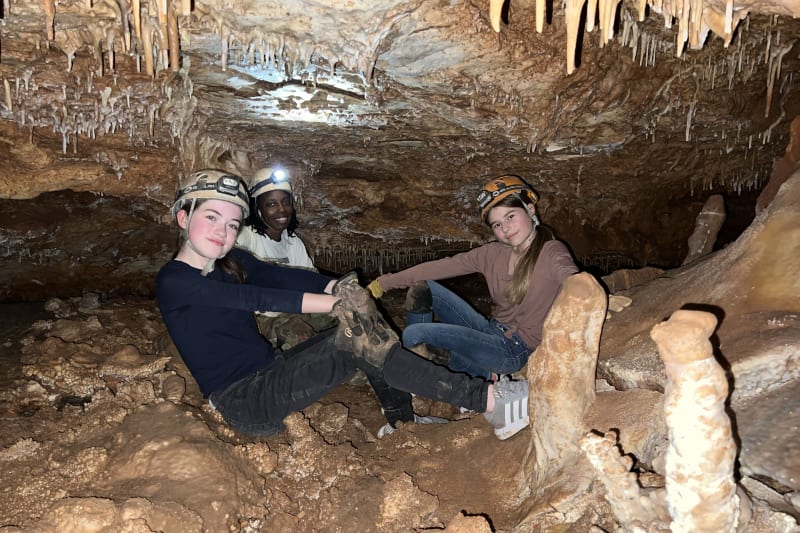What I like most about working at Trinity Episcopal School of Austin is the school’s growth mindset, commitment to assess our effectiveness, and willingness to adapt. The student is at the center of all these decisions — as it should be!
RELATED READING :: Top 5 Factors that Impact Student Success | Trinity Episcopal School of Austin
We continually look for ways to improve and, more importantly, take action to make those improvements. This applies to all areas of the school, from curriculum to classroom layout. We take an R&D-type approach to proactively research and consult with experts in the fields as we develop our programs and coursework, and that often includes seeking out what is working, not just in other schools and organizations but also on our own campus.
For example, this growth mindset recently led us to reimagine a class schedule that promotes deeper learning. Our new schedule has fewer transitions within the school day and longer core classes, extended to a full hour. This gives students more time to explore ideas within a particular course and make connections to learning experiences across all subject areas.
One of the more innovative aspects of our schedule is a later start on Thursdays at 9:00 a.m., as opposed to our normal start time at 8:00 (8:20 for grades 5–6). Teachers now have built-in time on Thursday mornings to collaborate, design, and align lessons and projects that are more integrated and lead to deeper learning. (Learn more about our student-centered schedules in Lower School, grades K–4, and Middle School, grades 5–8.)

But what is “deep learning,” and why is it important for young students? Sarah Fine, an education researcher and author, asked this question 10 years ago when she was a student at Harvard Graduate School of Education. Fine and Jah Mehta, an assistant professor, went on a nationwide mission to find schools where deeper learning was taking place. They shared their findings in their 2019 book, In Search of Deeper Learning. I encourage you to check out Episode 208 of the Cult of Pedagogy podcast to learn more about deeper learning and hear Sarah Fine discuss her work in more detail.
Fine and Jah Mehta split the idea of deep learning into three different domains – mastery, identity, and creativity. Mastery refers to developing knowledge or skills in a domain. Identity refers to thinking of yourself as someone who does that kind of work. And creativity refers to using the knowledge gained to make something meaningful from that knowledge. When talking about these three domains, Fine states that when interconnected in the experience of learning, learners tend to produce really powerful, rich, enduring learning.

Fine and Mehta found that deeper learning often took place not in core classes but rather in the periphery in classes like robotics, arts, and athletics. These classes have the upper hand since students often choose to be in these classes, and usually, there are more opportunities for leadership and authentic engagement. How can this level of deeper learning observed in electives and extracurriculars be implemented in core subjects, too? The authors discovered that in each classroom where deeper learning took place, there were three main components at play:
- Depth over breadth – instead of rushing through multiple different topics at a surface level, schools should provide students opportunities to take more time to learn fewer topics in more depth. Students develop real mastery when they really dig in.
- Student choice – even though students don’t choose the core classes that they have to take, the teacher can still offer some choice within that course. Choice can come in many different forms, but Fine suggests that teachers help students recognize what aspects of the course they’re most interested in and then have them take a deep dive. This speaks to the identity piece as they connect personally to their learning.
- Authentic audience – having students share their work with each other, and especially real-world audiences, rather than just submitting their work to their teachers for grade-oriented feedback, motivates students to take ownership of their learning. And the creativity that results is often pretty special when assignments are authentic.

By understanding how and why deeper learning takes place, we are able to find new ways to ensure it happens at Trinity Episcopal School. Our teachers are already quite good at engaging students in deeper learning. Our curriculum focuses on big ideas and units of study in which students can dig in and learn knowledge and skills that can then be transferred to novel and increasingly more complex situations. We promote student agency through differentiated learning, electives, extracurriculars, and student-to-student collaboration. And culminating performance tasks are a big part of the classroom experience.
As highlighted in Trinity’s five-year strategic plan, we see a big opportunity to promote each of these components of deeper learning in a more systematic way by further integrating our curriculum, which has also called for tweaking our schedule. When knowledge and skills transcend the confines of separate subject area classes, students can practice applying what they have learned in relevant, meaningful ways. In turn, they develop learning habits that last.
I’m really proud to be part of a school community that continually looks for new ways to improve and better serve our students. Trinity Episcopal School truly is a community of lifelong learners!
 About the Author
About the Author
Shanna Weiss is Head of Middle School at Trinity Episcopal School of Austin. Shanna is a long-time Tornado — she joined the Trinity faculty as a Spanish teacher in 2003, the first year we opened the Middle School. She taught Spanish and English for several years before taking on her current role overseeing the Middle School division in 2010. She graduated from Texas Tech University with a bachelor’s in Spanish. She also earned her master’s in Independent School Leadership from the Klingenstein Institute at Columbia University.











